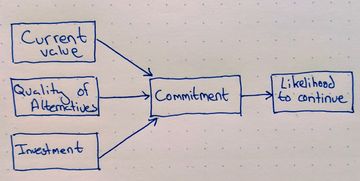All successful products are built on solid relationships with their users. These relationships are two-sided where the organization and the user are vested in each other and their mutual success. As a product leader it's important to recognize the relationship you are building with your user. Every change you make to the product will either deepen the relationship (increasing their commitment) or worsen it. And that's why this psychology model from 1998 about close interpersonal relationships is so important to product development.
According to this model, there are three factors to increasing commitment and therefore the likelihood a user will continue using your product.
- Satisfaction Level – This is the current level of user satisfaction with your product. The value they are getting from your product everytime they use it. You can measure this through CSAT, NPS, and frequency of use.
- Quality of Alternatives – How does your product compare to your competitors?
- Investment Size – How invested is your user? What will they lose if they were to leave your product? It could be time spent, score, data, change to process, cost to switch, and more.
By considering all three of these factors, you'll be able to build a relationship with your user resulting in a successful product.
